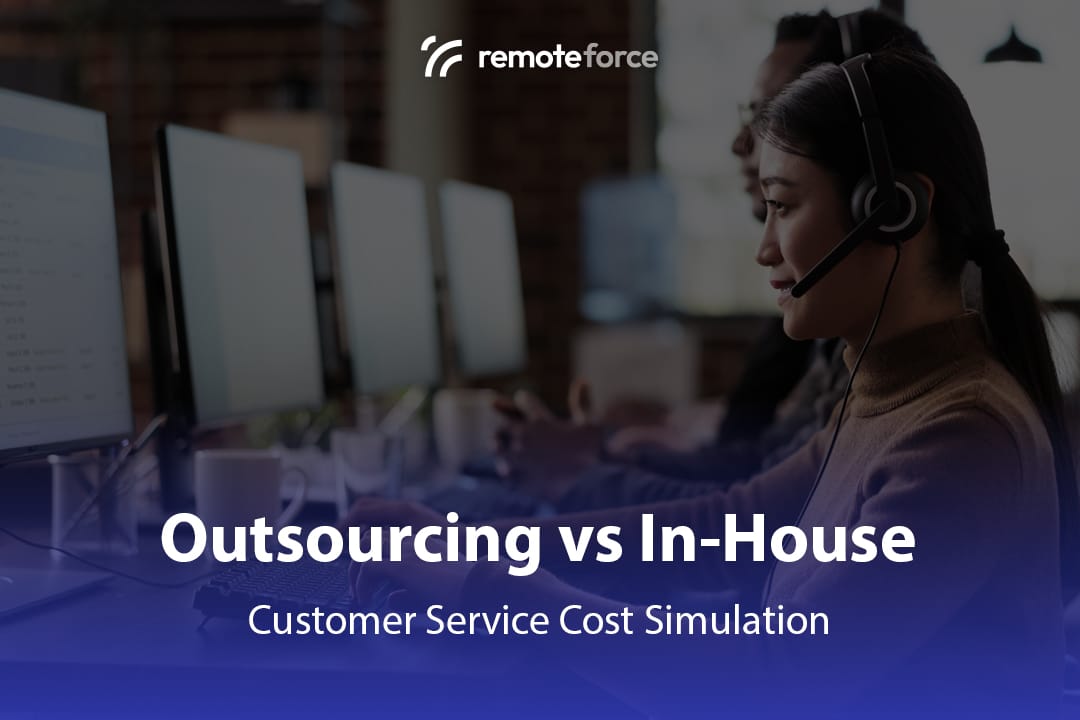Customer service is the lifeline of any business, directly impacting brand loyalty and sales retention. However, building and maintaining a high-performing support team—whether for technical queries, accounting support, or general customer relations—involves significant, often hidden, financial overhead.
The classic strategic dilemma is: Should we build an in-house team, or outsource the function?
While outsourcing often feels cheaper, many businesses struggle to calculate the Total Cost of Ownership (TCO) accurately. This article provides a comprehensive cost simulation, breaking down the true expenses of both models to reveal which one offers the maximum long-term value.
Table of Contents
ToggleThe Financial Reality of In-House Customer Service
When calculating the cost of an in-house customer service team, most companies only account for salaries. This approach severely underestimates the TCO, as the true burden lies in the fixed, variable, and indirect costs associated with employment.
1. Fixed and Direct Costs (The Visible Budget)
These are the costs directly tied to the employee’s compensation.
| Cost Component | Description | Annual Impact |
|---|---|---|
| Base Salary | The employee’s annual take-home pay. | 100% of agreed salary. |
| Benefits & Taxes | Payroll taxes, social security, health insurance, retirement contributions, paid time off (PTO). | Typically 25% – 40% of base salary. |
| Technology & Tools | Licensing fees for CRM software (e.g., Salesforce, Zendesk), VoIP phone systems, ticketing systems. | $500 – $1,500 per agent per year. |
| Office Space & Utilities | Rent, utilities, internet, desks, and computers for each seat. | Varies widely, often $6,000+ per seat annually. |
2. Variable and Hidden Costs (The Budget Killers)
These costs are unpredictable but inevitable, and they rarely appear in the initial budget.
- Recruitment and Onboarding: The expense of job postings, interview time, background checks, and HR processing for every new hire.
- Training & Development: Initial training time (when the agent is paid but not productive) and ongoing costs for refresher courses or compliance updates.
- Attrition & Turnover: The cost of replacing staff (which includes repeated recruitment and training costs). The average cost to replace a customer service agent can be upwards of $4,000 to $5,000 per instance.
- Supervision & Management: The salary and overhead of team leaders, supervisors, and quality assurance staff required to manage the agents.
The Financial Reality of Outsourced Customer Service
The outsourced model simplifies budgeting by consolidating most costs into a single, predictable fee, often structured as PMPM (Per-Employee, Per-Month) or an hourly rate.
1. Direct Costs (The Single, Predictable Fee)
The single fee paid to the outsourcing vendor is designed to cover the majority of the TCO.
| Cost Component | Description | Client Pays |
|---|---|---|
| PMPM/Hourly Rate | A comprehensive rate covering salary, benefits, local taxes, and the vendor’s profit/management fee. | A single, transparent monthly invoice. |
| Technology Stack | Licensing, maintenance, and setup of the advanced contact center technology, CRM, and security infrastructure. | Usually Included in the PMPM rate. |
| Management & HR | Vendor’s supervisory staff, HR, training, and legal compliance teams. | Included, eliminating the need for client oversight. |
2. Potential Add-Ons
While the model is designed to be all-inclusive, be sure to confirm if these are separate charges:
- Setup/Transition Fee: A one-time charge for initial knowledge transfer and system integration.
- Specialized Training: If the service requires highly specialized knowledge (e.g., advanced legal compliance or complex software diagnostics).
Cost Simulation: In-House vs Outsourced (10-Agent Team)
Let’s simulate the annual cost for a team of 10 Customer Service Agents in a general market, illustrating the true TCO difference.
| Cost Factor | In-House Team (Annual Cost) | Outsourced Partner (Annual Cost) |
|---|---|---|
| A. Base Salary (10 Agents @ $40,000) | $400,000 | Included in Vendor Fee |
| B. Benefits & Taxes (30% of Salary) | $120,000 | Included in Vendor Fee |
| C. Recruitment/Turnover (20% Attrition, $4k per hire) | $8,000 | $0 (Vendor absorbs this risk) |
| D. Office/Utilities/Hardware | $60,000 | $0 (Vendor provides infrastructure) |
| E. Technology (CRM/VoIP Licenses) | $10,000 | Included in Vendor Fee |
| F. Management/HR Support | $70,000 | Included in Vendor Fee |
| Total In-House TCO | $668,000 | $360,000 (Assumed rate: $3,000 PMPM) |
| Estimated Annual Savings by Outsourcing | – | $308,000 |
Note on Outsourced Cost: The assumed $3,000 PMPM rate includes the agent’s salary, benefits, all operational overhead, management fees, and the vendor’s profit margin.
The Simulation Result: In this common scenario, outsourcing the customer service function results in an estimated annual savings of over 46% compared to the actual Total Cost of Ownership of an equivalent in-house team.
Beyond TCO: The Strategic Value of Outsourcing
While the financial savings are compelling, the true value of outsourcing often lies in strategic advantages that further reduce long-term operational costs:
1. Instant Scalability and Flexibility
In-house teams struggle to scale quickly during peak seasons or sudden growth spurts. Outsourcing vendors, by contrast, can scale a 10-person team to 30 people within weeks, reducing the cost of missed opportunities and eliminating emergency, high-cost temporary staffing.
2. Risk Mitigation and Compliance
The vendor is responsible for all local labor laws, tax compliance, and regulatory changes, particularly in specialized fields like legal support or accounting. Outsourcing transfers the massive financial risk of non-compliance directly to the vendor, saving you from potential fines and legal costs.
3. Focus on Core Business
By offloading the non-core function of customer support, your internal management team can reallocate their time and capital toward strategic initiatives like product innovation, core web development, or direct sales efforts. This is perhaps the greatest non-financial cost saving.
Conclusion
The myth that in-house teams are always cheaper is dispelled when you factor in the true Total Cost of Ownership, which includes hidden expenses like attrition, technology, and management overhead. For non-core functions like customer service, the outsourcing model offers superior cost efficiency, predictable budgeting, and strategic risk transfer.
Ready to achieve substantial cost savings and gain specialized expertise without the burden of excessive overhead? RemoteForce offers highly professional and certified manpower solutions—from dedicated digital marketing teams to skilled secretarial and accounting staff. We provide compliant, scalable, and cost-effective outsourcing that focuses on optimizing your bottom line while ensuring superior quality. Contact us today to discuss a customized solution and see your exact savings simulation.




